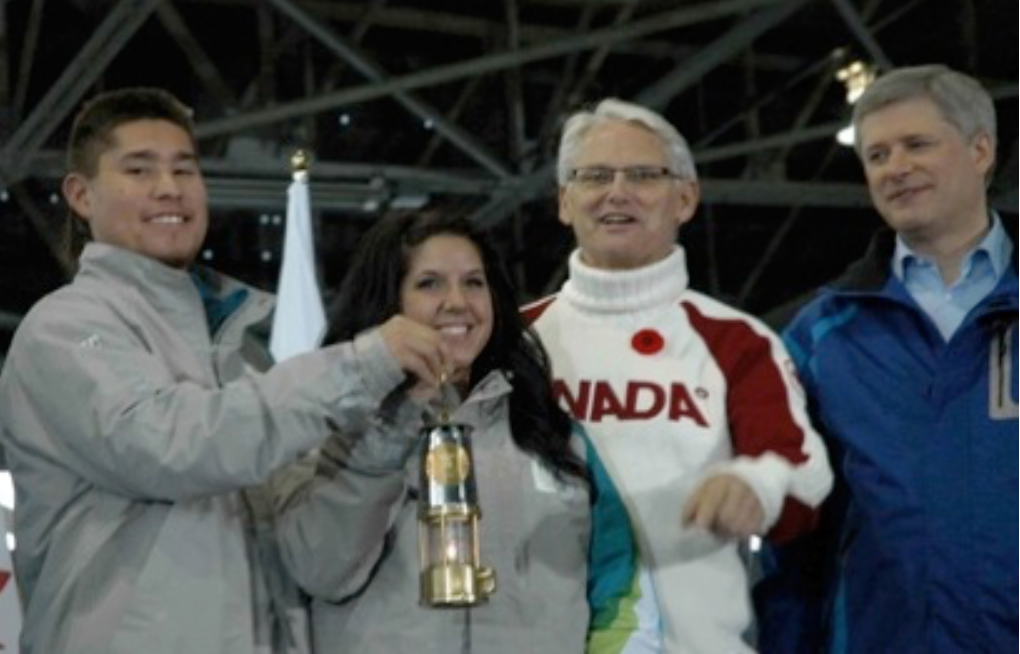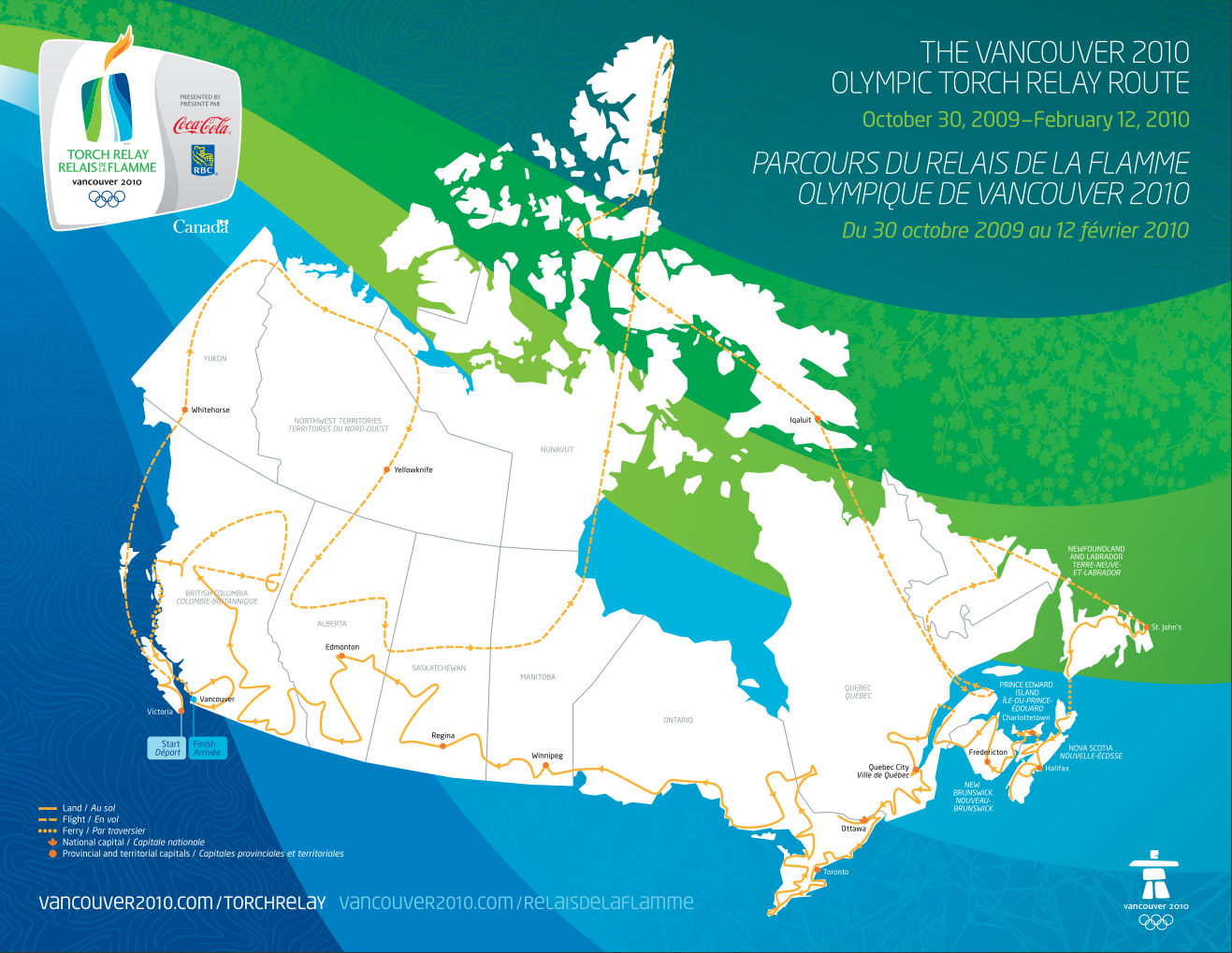
Bob Mackin
The Olympic flame’s journey to Vancouver began Oct. 22, 2009 in the midday sun at Ancient Olympia in Greece, the home of the original Olympics. Then, the next day, tragedy back home. Vancouver Olympics organizing committee chair Jack Poole had succumbed to a battle with pancreatic cancer. He was 76.
The VANOC delegation returned to Vancouver for his Oct. 27 funeral and then flew back to Greece, to retrieve the Olympic flame for the Oct. 30, 2009 launch of the domestic torch relay outside the Parliament Buildings in Victoria. The plaza beside the expanded Vancouver Convention Centre, where the Olympic cauldron was lit on the Feb. 12, 2010 opening day, was eventually named in Poole’s honour.
Here is an excerpt from the chapter about the beginning of the Vancouver 2010 Olympic Torch Relay’s Canadian leg, from my e-book, Red Mittens & Red Ink: The Vancouver Olympics, available via Smashwords and other online e-tailers.
The Canadian Forces CC-150 Polaris Airbus 15001 departed Athens, briefly stopped at Scotland’s Glasgow-Prestwick Airport and touched-down to change crews at Keflavik, Iceland. Capt. Garrett Lawless took control for the last leg to Victoria.

Premier Gordon Campbell and Prime Minister Stephen Harper at Victoria International Airport on Oct. 30, 2009 (Bob Mackin)
The commander at Trenton, Ontario, where both Lawless and the plane were based, was Col. Russell Williams. Williams welcomed the relay to the country’s biggest air force installation on December 15, but was sensationally arrested less than two months later for the sadistic murder of two women. He was convicted and sentenced to two 25-year life terms in jail, prompting the Canadian Forces to eject him from the service and burn his uniform. The case drew international media attention, not just because of Williams’s high-profile job, but for his self-portraits in women’s lingerie from a spree of residential break-ins.
The flight arrived an hour late at 8:45 a.m. on October 30 at Victoria International Airport. Vancouver Mayor Gregor Robertson emerged from the Airbus and strolled down the stairs to the tarmac where he set the miner’s lamp containing the flame. It was passed from politician to politician inside the 443 Maritime Patrol Squadron’s Sea King helicopter hangar under the watchful eye of Prime Minister Stephen Harper. The 443’s hornet badge contained the motto “our sting is death.”
The most complex and circuitous delivery from Victoria to Vancouver (just 69 kilometres away) was devised in 2008 by the Greater Victoria Spirit Committee which lobbied Victoria-area resident and VANOC executive vice-president Dan Doyle to make the capital of the Olympic province the start of the national relay.

The Vancouver 2010 Winter Olympics torch route (VANOC)
A police-escorted motorcade whisked the flickering flame in the miner’s lamp to downtown Victoria on the windy, rainy Friday where it was put aboard a traditional 13.5-metre, hand-carved red cedar canoe and paddled across the Inner Harbour by chiefs of the Squamish, Lil’wat, Tsleil-Waututh and Musqueam tribes from the Lower Mainland. Counterparts from Victoria’s Songhees and Esquimalt tribes greeted them at the dock, before the flame was carried to the Parliament Buildings.
Darlene Poole battled gusts of wind to ignite a cauldron on a temporary stage. Two-time Olympic speedskating champion Catriona Le May Doan and Sydney 2000 triathlon champion Simon Whitfield were the first of the 12,000 torchbearers on the 106-day, 1,030-community, 45,000 kilometre tour.
“I felt such a responsibility to everybody to do it properly and to do it with such pride,” said Whitfield, who also won silver at Beijing 2008.
Whitfield and Le May Doan transferred the flame to diver Alexandre Despatie of Laval, Quebec and retired Victoria rower Silken Laumann outside the landmark Fairmont Empress Hotel. The traveling production crew of 200 mustered the previous day for the $36 million tour and got H1N1 vaccination shots to protect them from the feared flu virus.

Jack Poole’s widow Darlene at the Olympic torch relay ceremony on the Legislature lawn, Oct. 30, 2009 (VANOC/Vancouver Archives)
The flame itself would be transported overnight between most communities by car, ferry or plane. The British Columbia government and municipalities paid for traffic, policing and community concerts to welcome the flame.
Onward it went to the Esquimalt naval base and around Victoria’s suburbs. At Elk Lake it was rowed by members of Canada’s Beijing 2008 gold medal-winning crew.
Darkness came early the day before Hallowe’en and 300 costumed and masked anti-Olympic protesters celebrated the occasion with a Zombie March from Centennial Square outside Victoria city hall. Police from Victoria and Vancouver Island in bright yellow jackets escorted the group. Even the Vancouver Police mounted squad showed up near Bastion Square.
The Vancouver 2010 Ford minivan, with the B.C. vanity licence plate Flame 8, was filled with torchbearers and waiting at Cook and Richardson streets with its lights turned out. Suddenly the van turned right and sped past people who had been waiting for hours to see the relay.
Protest leaders used mobile phones and text messaging to force a last-minute diversion near Government House, the mansion where Lt. Gov. Steven Point lived. A group of 10 torchbearers didn’t get their chance to run, but they did pass the flame from torch to torch in the presence of Point.
The flame finally came to the Parliamentary precinct where Victoria broadcaster Mel Cooper passed it to Jeneece Edroff, a teenage charity fundraiser who overcame a genetic spinal deformity. She re-lit the cauldron sparked earlier by Darlene Poole as fireworks lit up the Victoria sky.

Canada’s national rowing team with the Olympic flame on Elk Lake, Oct. 30, 2009 (VANOC/Vancouver Archives)
The protesters returned, with their own oversized, papier mache torch. As the rain-soaked concert attendees left on the rainy night, Campbell paced in his office at the Legislature’s west annex.
Vancouver 2010 Integrated Security Unit chief Bud Mercer was comfortably on a BC Ferry back to the mainland before Edroff’s torch was even lit. He monitored reports of the diversion via his BlackBerry smartphone. The night was in the hands of Victoria Police Department and its controversial chief Jamie Graham, who came to Vancouver and told his torch stories on November 1 to an audience of his peers.
Graham appeared at the 12th Vancouver International Security Conference. He believed the protesters were “probably going to be violent,” so uniformed police infiltrated the crowd.
“The relationships individual field officers have with protesters and so on just kills these kinds of disturbances and it worked extremely well,” Graham said in the Marriott Pinnacle ballroom.
The $220,000 bill was “well beyond” budget, but worth it. “Police departments from all over the country have taken our game plan, our operational plan and adopted it as their own,” Graham boasted.
The day was not without incident. Graham said two ferry passengers were arrested for dumping water on an undercover security person, while two motorcycle cops wiped out on slippery pavement. “One of them was hurt quite badly, but has since recovered,” he said.
Meanwhile, a secondary security vehicle “got T-boned by an old guy who ran a red light.”
Graham’s biggest revelation was that an undercover cop watched Lower Mainland anti-Olympic torch relay protesters in the rear-view mirror.
“You knew that the protesters weren’t that organized when on the ferry on the way over they all rented a bus, they all came over on a bus, and there was a cop driving the bus!” Graham said.

Hundreds of people protested the Victoria launch of the Olympic torch relay on Oct. 30, 2009. (TheDominionPaper.ca)
The story got national attention. Victoria photographer Bruce Dean complained to the Office of the Police Complaint Commissioner that Graham had violated police confidentiality. Dean was still angry after he was arrested and some of his photographs deleted in 2007 when he happened to come upon an undercover police operation in downtown Victoria.
Burnaby RCMP Chief Supt. Rick Taylor recommended in his report to the Office of the Police Complaint Commissioner that Graham be found in discreditable conduct. Graham claimed he was joking about the driver being a spook, but Taylor felt Graham “did cause concern amongst senior police personnel engaged in planning and security operations” for both the torch relay and 2010 Winter Olympics.
Graham was slapped with a similar penalty in 2007 for not cooperating with an investigation into Vancouver Police conduct on the Downtown Eastside during his tenure as Vancouver’s chief. He also made headlines in 2006 for leaving a used, autographed shooting range target on the desk of city manager and VANOC director Judy Rogers. “A bad day at the range is better than the best day at work,” he wrote to Rogers.
- Bob Mackin is author of the e-book Red Mittens & Red Ink: The Vancouver Olympics, the only independent history book about the Vancouver 2010 Winter Olympics. It is available from Smashwords and other online e-tailers.
Support theBreaker.news for as low as $2 a month on Patreon. Find out how. Click here.
(Bonus content below: the passenger manifest from the Canadian Forces jet that carried the Olympic flame from Greece to Canada and a video from the dress rehearsal for the Olympic flame lighting in Olympia.)
Passenger manifest for the Vancouver 2010 Winter Olympics torch flight by Bob Mackin on Scribd










